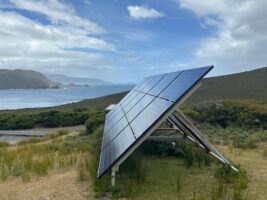In Spain, the government said it will pay 600 million euros ($633 million) annually to renewable and cogeneration power plants as it seeks to reassure investors and revive its comatose clean energy industry. The country guarantees a “reasonable yield of 7.4 percent,” the Ministry of Industry, Energy and Tourism said in an e-mailed statement Feb. 22. That applies from 2017 to 2019, with a review expected in 2020.
Spain’s clean-energy industry slumped after a wave of retroactive subsidy cuts that began in 2008, prompted by the European debt crisis. That cut payments for power-plant operators and stifled interest in building new ones. By guaranteeing a return, the government is seeking to spur development.
“They’re reassuring asset owners that their policy holds and they will get the yield they’re promised,” said Briony Bennett, policy analyst at Bloomberg New Energy Finance.
The southern European country has a goal of generating 20 percent of its energy from renewables by 2020. It has its first auction for new installations since the slump in 2016, inviting bids to build 500 megawatts of wind energy and 200 megawatts of biomass on the Iberian peninsula. Read more in the BNEF Insight Note here.
A second auction, originally planned for this quarter, is expected to auction off permits for 3 gigawatts, but will probably be delayed until at least the second quarter, according to the ministry.
Faster renewables growth may be assured in India, where the government has said the country will double the installed capacity in solar parks to 40 gigawatts, a measure aimed at fulfilling Prime Minister Narendra Modi’s ambitious green energy goals.
The world’s second most populous country will add 50 new solar parks to install another 20 gigawatts of capacity, Power Minister Piyush Goyal told reporters after a cabinet meeting. These projects will be completed by 2020 and will receive federal government funds worth 81 billion rupees ($1.21 billion).
“We will be giving central financial assistance of 2 million rupees per megawatt or 30 percent of project cost to each of these solar parks, whichever is lower,” Goyal said Feb. 22.
India is racing to add renewable energy capacity to achieve a target of 175 gigawatts by 2022 and meet commitments signed under the Paris climate accord last year. Its solar target of 100 gigawatts forms the biggest piece of the power-starved nation’s green pledge.
In the U.S., hydrogen has been back in the news. Royal Dutch Shell Plc said it will build seven fueling stations for hydrogen cars in California through a partnership with Toyota Motor Corp., laying down their latest bet on the demise of the internal-combustion engine.
The stations will nudge the state closer to its goal of having 100 retail sites by 2024 where hydrogen fuel-cell vehicles can fill up. The California Energy Commission is considering $16.4 million in grants toward the stations, with Shell and Toyota contributing $11.4 million.
The Shell-Toyota partnership “shows there’s a lot of interest and that the hydrogen market is poised to move forward rapidly,” said Janea Scott, a member of the California commission.
Toyota plans to rely on hydrogen to all-but-rid its lineup of traditional-engine models by 2050. The lack of refueling infrastructure is a major hurdle to zero-emission cars catching on with consumers—California has just 25 stations right now.
Shell also is crafting a strategy to wean itself off oil. Demand could peak in as few as five years, Chief Financial Officer Simon Henry said in November.
Also in California, Sempra Energy’s San Diego Gas & Electric utility and AES Corp. have completed the world’s biggest energy storage system—so far.
The 30-megawatt facility in Escondido, California, took nine months to build, includes 400,000 lithium-ion batteries, and can store enough electricity to supply 20,000 homes for four hours, the San Diego-based utility said in a statement Friday. AES has also completed a smaller, 7.5-megawatt storage facility in El Cajon.
San Diego Gas & Electric is increasing investments in storage to help balance supply and demand as more intermittent renewable energy sources like wind and solar power are added to the grid. California is requiring its utilities to get 50 percent of their electricity from renewable sources by 2030, and the utility expects to have at least 330 megawatts of storage on the grid by then.
In other storage-related news, the scaling back of a program encouraging residential solar in Japan has Panasonic Corp. hopeful the market for home energy storage systems is about to receive a boost.
In 2019, a program designed to buy back solar power flowing from rooftop panels at above-market rates will start becoming less enticing, potentially leaving homeowners who signed up with excess power on their hands. One answer could be to store that electricity: Osaka-based Panasonic is anticipating that installations of energy storage systems to combine with solar panels are set to rise.
Panasonic has been selling residential energy storage systems that include a battery and an inverter since 2012. In April, it will begin offering a new model that’s a third the size of the current version while also being able to be hung on an outer wall and installed using fewer parts.
“We are counting on more people preferring to consume electricity produced from their home solar panels on site, rather than selling it to power companies” once their incentives expire, said Ryo Matsumoto, who’s in charge of business planning and development at Panasonic’s Eco Solutions unit. “We are seeing 2019 as a turning point.”
Source: BNEF. Reproduced with permission.










